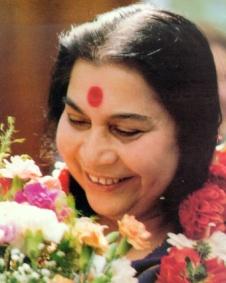
A spiritual guru with a mass following in India and abroad, Mata Nirmala Devi's USP is her ability to give mass kundalini awakenings, even granted over cyber space, through Sahaja Yoga.
The figure on the dais is small built and plump, with a broad fair face lit with a radiant smile. Framed by streaming locks of black hair and an enormous red bindi on the forehead, it has an elemental quality. One can imagine it astride a tiger, bearing a flaming trident. The face, of course, is familiar, the subject of thousands of posters plastered all over Mumbai, in Western India, that announce the arrival of well-known spiritual leader, Mata Nirmala Devi.
She has a mass following. Her annual Shivaji Park rallies attract a hundred thousand acolytes, celebrities jostle with each other for a sight, and to millions more her word is law. Sahaja Yoga centers dot 86 countries. She has been a guest speaker at the 1995 Beijing World Women's Conference. For four consecutive years she was invited by the UN to speak of world peace and in 1989 was awarded the United Nations Peace Prize. In Russia, research on Sahaja Yoga was granted full government sponsorship in 1989. In 1995, the government of Bulgaria honored her with a Peace Award and the Romanian government with an honorary doctorate in Cognitive Science. What is the secret of her popularity?
Nirmala Devi's appeal is unique. Her USP is her ability to give mass kundalini awakenings, through a system called Sahaja Yoga or Vishwa Nirmala Dharma. "If I've done anything worth mentioning, it is the ability to give collective realization," she has said on several occasions.
Traditionally, kundalini and its awakening have been
shrouded in mystery and awe. Most seekers view it as the maha shakti
(great power), whose ascent symbolizes the adept's spiritual progress
and manifests in fearful mental and physical experiences. Sages warn
against willfully raising the kundalini, for its premature arousal
can wreck damage. Nirmala Devi, however, makes it appear as easy as
falling off a log, with no damage to one's system. She even grants it
across cyberspace. Visitors to her
site are given instructions on how to raise their kundalini.
Indeed, I am here at a meeting with Maharashtra's IAS officers where she is scheduled to give a demonstration. We are asked to raise our palms upward, then to place the left hand on the liver while extending the right towards her, then finally to raise our palms above our heads. She asks us if we feel any cool air radiating either from our palms or the top of the heads, which according to her is the infallible sign of a risen kundalini. The other is thoughtlessness and peace of mind. In the air-conditioned hall, it is difficult to gauge whether the cool feeling is from the kundalini, or from a more temporal source. Nevertheless, I do feel some coolness from up on top, and I put up my hand when she asks for a hand count. A majority of the audience feels likewise, I notice. Nirmala Devi explains the relative ease with which she raises kundalini in the kali yug, the present Hindu era of darkness. "This is blossom time," she says, adding that she has "shortened the seeking".
If kundalini awakening is Mataji's calling card, it is also easily the most controversial aspect of her teaching. For traditionalists, it is impossible to believe that one can get self-realization in the time it takes to have a cup of tea. How valuable is such an awakening? Do the results last?
Willy Doctor, a management consultant and former Head of the department of Psychology at Sophia College, is a senior disciple of Mataji. She concedes that the original self-realization may wane unless followed up regularly with Sahaja Yoga meditation. Raising the kundalini then is only the initial spark.
Indeed, I am here at a meeting with Maharashtra's IAS officers where she is scheduled to give a demonstration. We are asked to raise our palms upward, then to place the left hand on the liver while extending the right towards her, then finally to raise our palms above our heads. She asks us if we feel any cool air radiating either from our palms or the top of the heads, which according to her is the infallible sign of a risen kundalini. The other is thoughtlessness and peace of mind. In the air-conditioned hall, it is difficult to gauge whether the cool feeling is from the kundalini, or from a more temporal source. Nevertheless, I do feel some coolness from up on top, and I put up my hand when she asks for a hand count. A majority of the audience feels likewise, I notice. Nirmala Devi explains the relative ease with which she raises kundalini in the kali yug, the present Hindu era of darkness. "This is blossom time," she says, adding that she has "shortened the seeking".
If kundalini awakening is Mataji's calling card, it is also easily the most controversial aspect of her teaching. For traditionalists, it is impossible to believe that one can get self-realization in the time it takes to have a cup of tea. How valuable is such an awakening? Do the results last?
Willy Doctor, a management consultant and former Head of the department of Psychology at Sophia College, is a senior disciple of Mataji. She concedes that the original self-realization may wane unless followed up regularly with Sahaja Yoga meditation. Raising the kundalini then is only the initial spark.